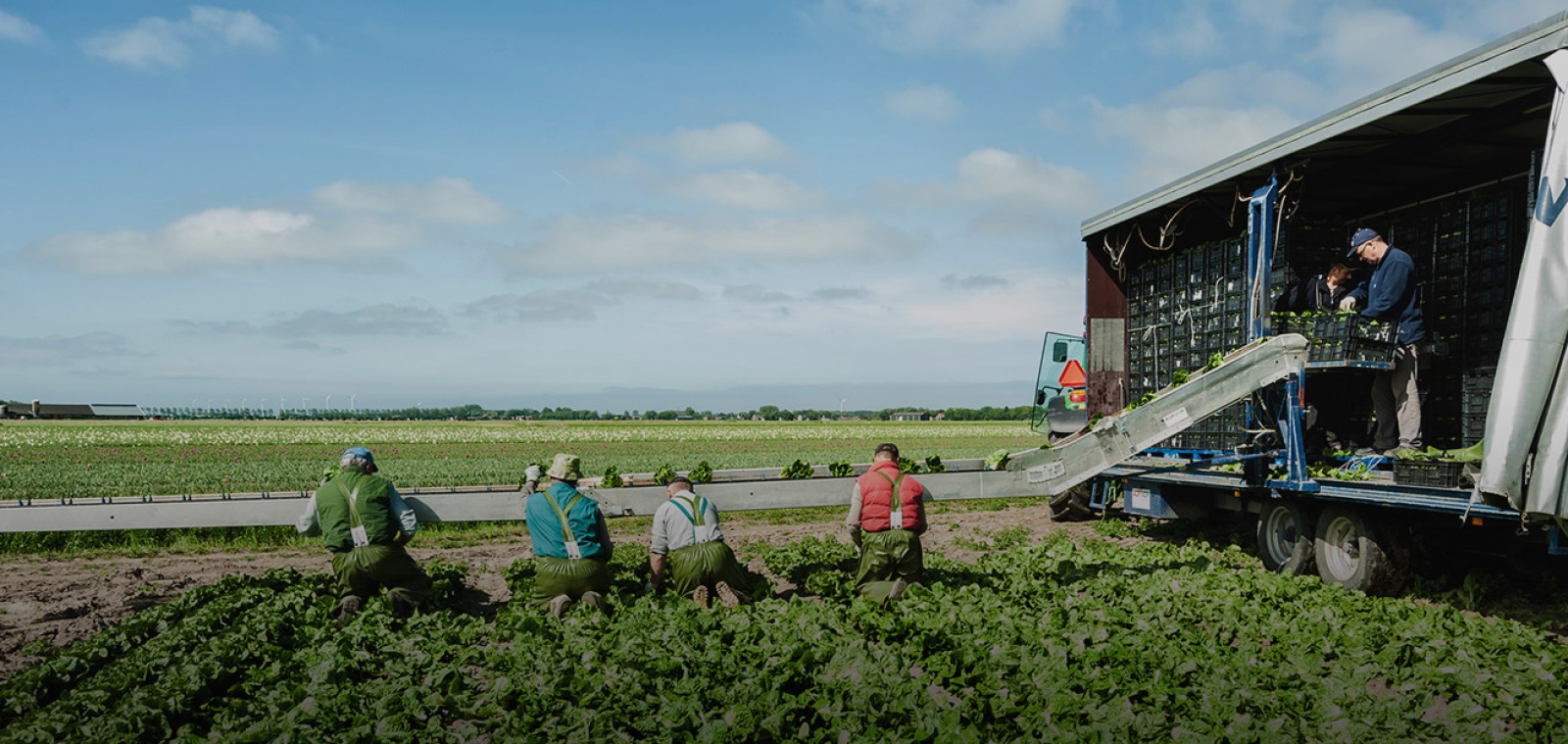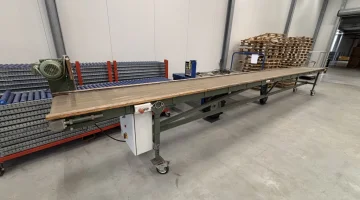- All
- Inspection conveyors (15)
- Flat conveyors (227)
- Pot holders (209)
- Elevator incline conveyors (91)
- Potted plant conveyors (74)
- Roller conveyors (71)
- Potting machines (63)
- Curved conveyors (39)
- Box tippers (37)
- Dosing hoppers (31)
- Flow pack machines (29)
- Weighing machine (28)
- Cutting machines (26)
- Production and packaging lines (25)
- Apple & Fruit sorting machines (20)
- Tray seeding machines (20)
- Washing machines for vegetables (19)
- Shaking bedlifters (19)
- Turntables (19)
- Palletizers (19)
- Potato sorting machines (17)
- Binding machines (16)
- Flower processing machines (16)
- Net packaging and clipping machines (16)
- Bedlifters (15)
- Tomato sorting machines (15)
- Ventilators (14)
- Work tables (14)
- Hill formers (14)
- Lettuce planting machines (13)
- Harvesting trolleys and trailers (13)
- Label sticker machines (13)
- Buffer conveyor (12)
- Pipe rail trolleys (11)
- Trailers (11)
- Bedplanting machines (11)
- Scales (10)
- Roller inspection conveyors (10)
- Leek harvesters (10)
- Pepper sorting machines (10)
- Top seal packaging machines (10)
- Electro pipe rail trolleys (9)
- Sorting machines for flower bulbs and Brussels sprouts (9)
- Brushing machines (8)
- Cucumber sorting machines (8)
- Asparagus washing & cutting machines (8)
- Leek washing and peeling machines (8)
- Tray filling machines (8)
- Water unloaders (8)
- Box fillers (8)
- Check weighers (8)
- Bucket and pail filling machines (8)
- Knife peeling machines (8)
- Vibratory feeding hoppers (8)
- Carrot harvesters (7)
- Cucumber wrapping machines (7)
- Pot plant buffer conveyor belts (7)
- Denesters (7)
- Crate washer and tray washing machines (7)
- Onion harvesters (7)
- Spading machines (7)
- Transport and spacing forks (6)
- Cherry sorting machines (6)
- Stretch film packaging machines (6)
- Leek hole punching machines (6)
- Onion haulm toppers (6)
- Roller sorting machines (6)
- Shrub and tree lifters (5)
- Spraying wagons (5)
- Winding machines (5)
- Shrink wrap packaging machines (5)
- Plastic mulch layer machines (5)
- Plastic foil & mulch planting machine (5)
- Rose sealing machines (5)
- Pruning machines (5)
- Inter row cultivators (5)
- Weed burners (5)
- Metal detectors (5)
- Pallet wrappers (5)
- Box lifts (4)
- Soil bunkers (4)
- Harvesting conveyors (4)
- Vibratory pregraders (4)
- Asparagus sorting machines (4)
- Bedformers (4)
- Cultivators (4)
- Counting machines (4)
- Potdispensing forks (4)
- Fertilizers (4)
- Weight grading machines (4)
- Screw conveyors (4)
- Soil & peat blocking machines (4)
- Pot topping machines (4)
- Rose sorting & processing machines (4)
- Receiving hoppers (4)
- Brush Polishers (4)
- Drum / barrel washing machines for vegetables (4)
- Onion neck toppers (3)
- Big-Bale dosage bunker (3)
- Mowers (3)
- Leek planting machines (3)
- Cartons box & tray forming & erecting machines (3)
- Shovel containers (3)
- Deleafing machines (3)
- Carousel planting machines (3)
- Netting machines for root balls (3)
- Watering units (3)
- Foil wrapping machines (3)
- Inter row rotovators (3)
- Pregraders (3)
- Drying machines for fruit and vegetables (3)
- Potato harvesters (3)
- Forklifts (2)
- Potatoes selection wagons (2)
- Haulm toppers for potatoes (2)
- Shredders (2)
- High pressure pumps (2)
- Onions & Bulbs planting machines (2)
- Telescope conveyors (2)
- Chunk / Length grading machines (2)
- Tomato drying machines (2)
- Flower bunching tables (2)
- Compressors (2)
- Electro transport trolleys (2)
- Pallet strapping machines (2)
- Brussel sprouts harvesting machines (2)
- Pneumatic sowing machines (2)
- Tipping containers (2)
- Rotary cultivators (2)
- Debulbing machines for tulips (2)
- Banding machines (2)
- Tractors (2)
- Soil mixers (2)
- Big bag fillers (2)
- Destacking machines (2)
- Hygienic entrances (2)
- Disinfection machines (2)
- Spraying booms (1)
- Cabbage harvesters (1)
- Flail mowers (1)
- Flower bulbs peeling machines (1)
- Optical grading machines that grade on quality (1)
- Separators (1)
- Lily planting machines (1)
- Foggers LVM (1)
- Chain conveyors (1)
- Picking trolleys (1)
- Danish trolleys (1)
- Irrigation pumps (1)
- Cleaning and removing machines during crop rotation (1)
- Garlic harvesters (1)
- Destoners (1)
- Mechanical seeders (1)
- Trough conveyors (1)
- Dryers (1)
- Spinach harvesters (1)
- Supports (1)
- Store loaders (1)
- Sewing machine (1)
- Stacking machines (1)
- Greenhouse roof cleaners (1)
- Scooter pick up loaders (1)
- Mobile elevator conveyor (1)
- Topbeltlifters for trees (1)
- Show more (164)Show less
- All
- Vegetables (9)
- Flower bulbs (9)
- Potatoes (8)
- Onions (7)
- Brussels sprouts (6)
- Fruits (6)
- Carrots (4)
- Flowers (3)
- Recycling (3)
- Citrus and lemons (3)
- Avocados (3)
- Mangoes (3)
- Peppers (3)
- Broccoli (2)
- Cabbage (2)
- Apples (2)
- Potplants (2)
- Tree nursery (2)
- Sweet potatoes (2)
- Leafy vegetables (2)
- Pears (2)
- Chicory (2)
- Oranges (2)
- Tomatoes (2)
- Plums (2)
- Apricots (2)
- Nectarines (2)
- Peaches (2)
- Kiwis (2)
- Fennel (1)
- Perennials (1)
- Radish (1)
- Celery (1)
- Spring onions (1)
- Cherries (1)
- Pumpkin (1)
- Melons (1)
- Trays (1)
- Garlic (1)
- Herbs (1)
- Mushrooms (1)
- Cauliflower (1)
- Spinach (1)
- Lettuce (1)
- Berries (1)
- Peonies (1)
- Zucchini (1)
- Eggplant (1)
- Strawberries (1)
- Tulips (1)
- Leek (1)
- Asparagus (1)
- Cucumbers (1)
- (Red) Beets (1)
- Show more (46)Show less
Be the first to receive new additional machines in your mailbox with any of the following features.
Used Inspection conveyors
![Compas TBU 60X800 inspection conveyor]()
Compas TBU 60X800 inspection conveyor
![Perfect inspection conveyor with elevator]() Sold under reservation
Sold under reservationPerfect inspection conveyor with elevator
![AWB inspection conveyor with dosing conveyor and vibrating screen]()
AWB inspection conveyor with dosing conveyor and vibrating screen
![Keulmac inspection conveyor 550 x 60 cm]()
Keulmac inspection conveyor 550 x 60 cm
![Stas Combi double packing conveyor with 16 scales]()
Stas Combi double packing conveyor with 16 scales
![Inspection conveyor 155 x 115 cm]()
Inspection conveyor 155 x 115 cm
![Schouten inspection conveyor 210 x 80 cm]()
Schouten inspection conveyor 210 x 80 cm
![Schouten TBL450-80 inspection conveyor 450 x 80 cm]()
Schouten TBL450-80 inspection conveyor 450 x 80 cm
![Compas inspection conveyor 615 x 100 cm]()
Compas inspection conveyor 615 x 100 cm
![Compas 80X300S inspection conveyor 300 x 80 cm, with dosing conveyor 100 x 80 cm]()
Compas 80X300S inspection conveyor 300 x 80 cm, with dosing conveyor 100 x 80 cm
![Danfoss VLT midi drive inverter T/C:fc-280pk55T4E20H2BXCXXXSXXXXAN 0,55KW]() New machine
New machineDanfoss VLT midi drive inverter T/C:fc-280pk55T4E20H2BXCXXXSXXXXAN 0,55KW
![Roller inspection conveyor 250 x 85 cm, new]() New machine
New machineRoller inspection conveyor 250 x 85 cm, new
![Lenze L-Force Multi Drive HighLine inverter]()
Lenze L-Force Multi Drive HighLine inverter
![New switchbox with frequency inverter for motors up to 1,5 kw]()
New switchbox with frequency inverter for motors up to 1,5 kw
![New custom conveyor belt, dimensions to customer requirements]() New machine
New machineNew custom conveyor belt, dimensions to customer requirements
- Quality equipment
- Skilled personnel
- Worldwide delivery
- Since 1977
Got a machine for sale?
We are constantly looking for good quality agricultural and horticultural machinery.
About second-hand Inspection conveyors
A inspection conveyor makes it possible to subject fruit, vegetables or other products before grading or processing to a final visual check for quality. Any inferior-quality fruit and vegetables or foreign objects are then removed by hand.
Inspection conveyors belts with adjustable speed
Flat inspection conveyors are generally speed-adjustable so that the person standing at the inspection conveyor has enough time to inspect everything properly. The speed can be controlled by means of a variable speed drive, motor or a pulley system. In some cases, the inspection table is placed in a closed-off cubicle with an overpressure system. Some of these are heated. A lamp can also be suspended above the inspection table.
Difference between flat and roller inspection conveyors
Round products are often inspected using a roller inspection conveyor. The advantage to this in comparison to a flat conveyor belt is that the product rotates while being conveyed. This makes it easier to inspect all sides of the product properly.
Advantages of a flat inspection conveyor belt
Rollers are not ideal for smaller or fragile non-round products. Therefore, a flat inspection conveyor belt is best for products like berries, cherries, lettuce, cabbage, broccoli, beans, mini-tubers or flower bulbs. Flat inspection belts are often used for recycling materials.
Peeling conveyors for flower bulbs
When peeling flower bulbs, the roots are removed, and any bulbs attached to other bulbs are pulled apart if necessary. The bulbs of some flowers, such as tulips, can largely be peeled with a machine. Because not all the flower bulbs are peeled successfully using a machine, this is followed by manual peeling at a peeling conveyor. This is usually part of a grading line and is positioned between the grading machine and the counting machine. Some peeling conveyors are fitted with a vibratory sieve at the beginning or end to get rid of bits of loose skin and sand.
Do you have any questions about one of the inspection conveyor belts or grading conveyors on this page? Do you want to know if inspection belts are available with adjustable speeds, for example? Don’t hesitate to contact one of our staff members. They will be happy to assist and advise you in finding a suitable used inspection conveyor.
 Request an offer (
Request an offer (

.jpg?resolution=360x200&quality=85&type=webp)
.jpg?resolution=360x200&quality=85&type=webp)
.jpg?resolution=360x200&quality=85&type=webp)
.jpg?resolution=360x200&quality=85&type=webp)

.jpg?resolution=360x200&quality=85&type=webp)

.jpg?resolution=360x200&quality=85&type=webp)


.jpg?resolution=360x200&quality=85&type=webp)
.jpg?resolution=360x200&quality=85&type=webp)

